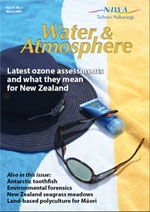PDF of this article (230 KB)



John Leathwick has mined NIWA’s New Zealand Freshwater Fish Database and modelled the statistical likelihood of finding fish A in stream B. The next step is predicting where to look.
Over the years, a considerable number of New Zealand’s rivers and streams have been fished to collect information about the distribution and abundance of native fish such as eels and galaxids, and introduced fish such as brown and rainbow trout. This information is stored in NIWA’s Freshwater Fish Database, which now contains data from over 20 000 sites. We have been working with these data to create statistical models that describe how the likelihood of capturing individual fish species varies depending on the nature of the river or stream.
So far, we’ve developed descriptive models for more than 30 native fish species. About half of these are migratory, spending at least some part of their life in the sea, while the remainder are relatively sedentary, spending all their lives in freshwater. The migrants include some well-known fish such as longfin and shortfin eel, along with several species of whitebait, including inanga, koaro, and banded and giant kokopu. The non-migratory species are much less commonly seen, and occur mostly in the eastern South Island; several of these are now rare or threatened.
Some like it flat
The models indicate some very strong contrasts in the conditions preferred by these two groups of species. The majority of migratory species are most commonly caught within 50 km of the coast, although species such as longfin eel and koaro move considerable distances inland. However, the distributions of these species are also affected by the downstream river gradient – most species will penetrate some distance inland where river gradients are gentle (less than 0.5°), but become increasingly restricted to more coastal sites as river gradients increase. Steep river segments and waterfalls also play an important role for migrants, blocking the path upstream to varying degrees. Fish such as inanga, smelt, black flounder, and grey mullet, show very little climbing ability, while others, such as longfin eels, koaro, and banded kokopu, are capable of negotiating local obstacles with considerable slope, particularly if they are close to the coast.
By contrast, the majority of non-migratory species are caught most frequently in inland rivers and streams, and a number of these species appear to be remarkably tolerant of cold temperatures, particularly in winter. Most of these natives also occur in catchments where significant rain (more than 25 mm in a day) is infrequent, and with strongly fluctuating river flows through the year. This might reflect conditions that are less favourable for introduced species such as trout, which are a significant predator of these natives.
Power of prediction
One interesting spin-off from these models is their usefulness for making predictions across New Zealand’s entire river and stream network. We can use each species model to predict the probability of capture for rivers and streams throughout New Zealand, including those not fished. Predictions are made on the basis of the statistical description of the relationship between capture of each species and the environment, adjusted for the time of year and fishing method. The predictions reflect the individual species’ responses to factors such as the distance from the coast, downstream slopes, the temperature, the amount of water flow and its variability, the degree of riparian shading, the frequency of rain-days, and the degree of native vegetation cover in the upstream catchment.
Predictions can be made not only for current environmental conditions, but also for those that were likely to prevail before human modification of New Zealand’s landscapes. This allows comparison, for example, of the expected distribution of banded kokopu (which prefer small, coastal, densely shaded streams) prior to human settlement and following the extensive clearance of riparian vegetation that has occurred over the last 150 years.
From models to maps
By combining the predictions for all these species, we can create maps showing the expected native fish community patterns for our rivers and streams. This is valuable for conservation management, allowing assessment of the degree of protection afforded to different fish species and communities. This information can, in turn, be used to highlight those species or communities that are least protected, and to identify sites where restoration of more favourable conditions (for example, through riparian planting or ameliorating obstructions caused by culverts) could be expected to provide the greatest biodiversity benefits.
Similar models have also been fitted for a range of introduced fish, including brown and rainbow trout, and pests such as koi carp, gambusia (mosquito fish), and catfish. Models for trout are proving valuable for understanding the interactions between these species and our native fish. Similarly, models for pest fish that are patchily distributed, such as catfish and koi carp, are useful for indicating suitable environments for these species; managers can use this information to set up surveillance in likely environments to insure that the pests never have a chance to become established.
The logical conclusion: predictive models of native fish distributions provide a powerful tool for conservation planning in New Zealand’s rivers and streams.
Vital statistics
- Models based on the NZ Freshwater Fish Database show where in a stream different species are likely to live – or to have lived before landscape modification.
- Fish preferences are tied to stream slope and distance from the coast.
- The models can generate maps to show present-day and likely past distributions.
Further reading and useful links
Richardson, J. (2006). Database tops 25,000 records. Water & Atmosphere 14(3): 6.
New Zealand Freshwater Fish Database: www.niwascience.co.nz/services/nzffd
Natives and introduced species in the NIWA Atlas of Zealand Freshwater Fishes: www.niwa.co.nz/rc/freshwater/fishatlas
Dr John Leathwick is an ecosystem modeller based at NIWA in Hamilton. His research interests include native biodiversity, environmental classification, conservation management, and statistical modelling.
Teachers’ resource for NCEA Achievement Standards or Unit Standards: Mathematics Level 2 AS90289, Level 3 AS90641 See other curriculum connections at www.niwa.co.nz/pubs/wa/resources
